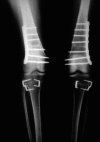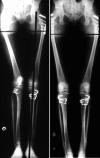Bilateral double osteotomy in severe torsional malalignment syndrome: 16 years follow-up
- PMID: 23989854
- PMCID: PMC4033816
- DOI: 10.1007/s10195-013-0260-0
Bilateral double osteotomy in severe torsional malalignment syndrome: 16 years follow-up
Abstract
Background: Torsional malalignment syndrome (TMS) is a well defined condition consisting of a combination of femoral antetorsion and tibial lateral torsion. The axis of knee motion is medially rotated. This may lead to patellofemoral malalignment with an increased Q angle and chondromalacia, patellar subluxation and dislocation. Conservative management is recommended in all but the most rare and severest cases. In these cases deformity correction requires osteotomies at two levels per limb.
Materials and methods: From 1987 to 2002 in our institution three patients underwent double femoral and tibial osteotomy for TMS bilateral correction (12 osteotomies). All patients were reviewed at mean follow-up of 16 years.
Results: At final follow-up no patients reported persistence of knee or hip pain. At clinical examination both lower limbs showed a normal axis and a normal patella anterior position. Pre-operative femoral version measurement showed an average hip internal rotation of 81.5° (range 80°-85°) and average hip external rotation of 27.2° (10°-40°). Thigh-foot angle measurement showed an average value of 38.6° (32°-45°). At final follow-up femoral version measurement showed an average hip internal rotation of 49° (range 45°-55°) and average hip internal rotation of 44.3° (20°-48°) (Figs. 1, 2, 3, 4, 5, 6). Thigh-foot angles measurement showed an average value of 21.6° (18°-24°) outward.
Conclusion: We recommend a clinical, radiographical and CT scan evaluation of all torsional deformity. In cases of significant deformity, internally rotating the tibia alone is not sufficient. Ipsilateral outward femoral and inward tibial osteotomies are our current recommendation for TMS, both performed at the same surgical setting.
Figures






Similar articles
-
Surgical treatment for recurrent patellar dislocation with severe torsional deformities: Double-level derotational osteotomy may not have a clear advantage over single-level derotational osteotomy in improving clinical and radiological outcomes.Knee Surg Sports Traumatol Arthrosc. 2024 Sep;32(9):2248-2257. doi: 10.1002/ksa.12246. Epub 2024 May 15. Knee Surg Sports Traumatol Arthrosc. 2024. PMID: 38751078
-
Double-level torsional osteotomy a treatment for the 'inwardly pointing knee' syndrome.Arch Orthop Trauma Surg. 2023 Jun;143(6):2863-2875. doi: 10.1007/s00402-022-04446-w. Epub 2022 May 12. Arch Orthop Trauma Surg. 2023. PMID: 35551448 Free PMC article.
-
Combined distal femoral osteotomy and tibial tuberosity distalization is effective in patients presenting with patellar instability and patellofemoral pain due to patella alta and femoral malalignment.Arch Orthop Trauma Surg. 2023 May;143(5):2557-2563. doi: 10.1007/s00402-022-04541-y. Epub 2022 Jul 21. Arch Orthop Trauma Surg. 2023. PMID: 35861870
-
Torsional Osteotomy.J Knee Surg. 2020 May;33(5):486-495. doi: 10.1055/s-0039-1678677. Epub 2019 Feb 8. J Knee Surg. 2020. PMID: 30736056 Review.
-
[Osteotomies].Orthopade. 2008 Sep;37(9):872, 874-6, 878-80 passim. doi: 10.1007/s00132-008-1294-5. Orthopade. 2008. PMID: 18682913 Review. German.
Cited by
-
Three-dimensional biplanar radiography as a new means of accessing femoral version: a comparitive study of EOS three-dimensional radiography versus computed tomography.Skeletal Radiol. 2015 Feb;44(2):255-60. doi: 10.1007/s00256-014-2031-2. Epub 2014 Oct 17. Skeletal Radiol. 2015. PMID: 25319563
-
Surgical management of miserable malalignment of the lower limb: a systematic review.Eur J Orthop Surg Traumatol. 2025 Jun 23;35(1):270. doi: 10.1007/s00590-025-04375-5. Eur J Orthop Surg Traumatol. 2025. PMID: 40548979 Review. No abstract available.
-
Tibial Derotational Osteotomy for Patellofemoral Instability: A Systematic Review.Adv Orthop. 2022 Dec 28;2022:8672113. doi: 10.1155/2022/8672113. eCollection 2022. Adv Orthop. 2022. PMID: 36620474 Free PMC article.
-
Derotational Femoral Osteotomy for Treating Recurrent Patellar Dislocation in the Presence of Increased Femoral Anteversion: A Systematic Review.Orthop J Sports Med. 2021 Nov 22;9(11):23259671211057126. doi: 10.1177/23259671211057126. eCollection 2021 Nov. Orthop J Sports Med. 2021. PMID: 34881342 Free PMC article. Review.
-
Correction of Tetratorsional Malalignment of the Lower Extremities Improves Patient-Reported Outcomes.HSS J. 2024 Nov;20(4):522-529. doi: 10.1177/15563316231183443. Epub 2023 Jul 1. HSS J. 2024. PMID: 39483668
References
-
- James SL. Chondromalacia of the patella in the adolescent. In: Kennedy JC, editor. The injured adolescent knee. Baltimore: Williams & Wilkins; 1979. pp. 205–251.
-
- Staheli LT. Torsion: treatment indications. Clin Orthop Relat Res. 1989;247:61–66. - PubMed
-
- Lerat JL, Moyen B, Bochu M. Clinical examination of bone axes in adult. Tomodensitometry. Rev Chir Orthop Reparatrice Appar Mot. 1982;68(1):37–43. - PubMed
-
- Staheli LT, Corbett M, Wyss C, King H. Lower-extremity rotational problems in children. Normal values to guide management. J Bone Joint Surg Am. 1985;67(1):39–47. - PubMed
MeSH terms
LinkOut - more resources
Full Text Sources
Other Literature Sources

